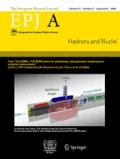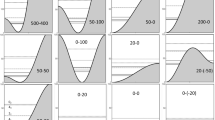Abstract.
Effective field theory is generalized to investigate the rotational motion of triaxially deformed even-even nuclei. The Hamiltonian for the triaxial rotor is obtained up to next-to-leading order within the effective field theory formalism. Its applicability is examined by comparing with a five-dimensional rotor-vibrator Hamiltonian for the description of the energy spectra of the ground state and \( \gamma\) band in Ru isotopes. It is found that by taking into account the next-to-leading order corrections, the ground state band in the whole spin region and the \( \gamma\) band in the low spin region are well described. The deviations for high-spin states in the \( \gamma\) bands point towards the importance of including vibrational degrees of freedom in the effective field theory formulation.
Similar content being viewed by others
References
A. Bohr, B.R. Mottelson, Nuclear structure, Vol. II (Benjamin, New York, 1975)
F. Iachello, A. Arima, The Interacting Boson Model (Cambridge University Press, Cambridge, 1987)
T. Papenbrock, Nucl. Phys. A 852, 36 (2011)
J.L. Zhang, T. Papenbrock, Phys. Rev. C 87, 034323 (2013)
T. Papenbrock, H.A. Weidenmüller, Phys. Rev. C 89, 014334 (2014)
T. Papenbrock, H.A. Weidenmüller, J. Phys. G: Nucl. Part. Phys. 42, 105103 (2015)
T. Papenbrock, H.A. Weidenmüller, Phys. Scr. 91, 053004 (2016)
E.A. Coello Pérez, T. Papenbrock, Phys. Rev. C 92, 014323 (2015)
E.A. Coello Pérez, T. Papenbrock, Phys. Rev. C 92, 064309 (2015)
E.A. Coello Pérez, T. Papenbrock, Phys. Rev. C 94, 054316 (2016)
U. van Kolck, Phys. Rev. C 49, 2932 (1994)
E. Epelbaum, H.-W. Hammer, U.-G. Meißner, Rev. Mod. Phys. 81, 1773 (2009)
X.-L. Ren, K.-W. Li, L.-S. Geng, B.-W. Long, P. Ring, J. Meng, arXiv:1611.08475 [nucl-th] (2016)
C. Bertulani, H.-W. Hammer, U. van Kolck, Nucl. Phys. A 712, 37 (2002)
H.-W. Hammer, D. Phillips, Nucl. Phys. A 865, 17 (2011)
E. Ryberg, C. Forssén, H.-W. Hammer, L. Platter, Phys. Rev. C 89, 014325 (2014)
P.F. Bedaque, U. van Kolck, Annu. Rev. Nucl. Part. Sci. 52, 339 (2002)
H. Grießhammer, J. McGovern, D. Phillips, G. Feldman, Prog. Part. Nucl. Phys. 67, 841 (2012)
H.-W. Hammer, A. Nogga, A. Schwenk, Rev. Mod. Phys. 85, 197 (2013)
R. Bengtsson, H. Frisk, F. May, J. Pinston, Nucl. Phys. A 415, 189 (1984)
I. Hamamoto, H. Sagawa, Phys. Lett. B 201, 415 (1988)
S. Frauendorf, J. Meng, Nucl. Phys. A 617, 131 (1997)
J. Meng, J. Peng, S.Q. Zhang, S.-G. Zhou, Phys. Rev. C 73, 037303 (2006)
S. Coleman, J. Wess, B. Zumino, Phys. Rev. 177, 2239 (1969)
C.G. Callan, S. Coleman, J. Wess, B. Zumino, Phys. Rev. 177, 2247 (1969)
T. Brauner, Symmetry 2, 609 (2010)
P. Ring, P. Schuck, The Nuclear Many Body Problem (Springer Verlag, Berlin, 1980)
A.S. Davydov, G.F. Filippov, Nucl. Phys. 8, 237 (1958)
T. Niksić, D. Vretenar, P. Ring, Prog. Part. Nucl. Phys. 66, 519 (2011)
P.W. Zhao, Z.P. Li, J.M. Yao, J. Meng, Phys. Rev. C 82, 054319 (2010)
Z.P. Li, T. Nikšć, P. Ring, D. Vretenar, J.M. Yao, J. Meng, Phys. Rev. C 86, 034334 (2012)
R. Bengtsson, S. Frauendorf, Nucl. Phys. A 327, 139 (1979)
Author information
Authors and Affiliations
Corresponding author
Additional information
Communicated by D. Blaschke
Rights and permissions
About this article
Cite this article
Chen, Q.B., Kaiser, N., Meißner, UG. et al. Effective field theory for triaxially deformed nuclei. Eur. Phys. J. A 53, 204 (2017). https://doi.org/10.1140/epja/i2017-12404-5
Received:
Accepted:
Published:
DOI: https://doi.org/10.1140/epja/i2017-12404-5



